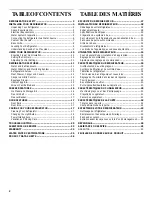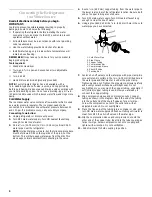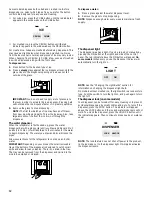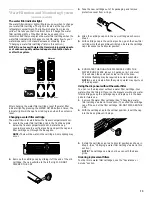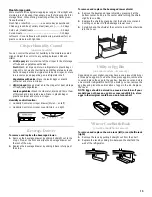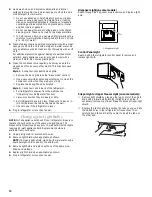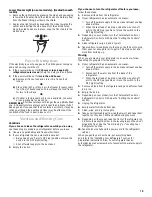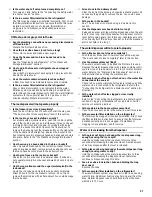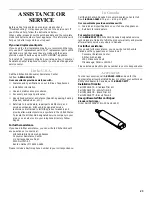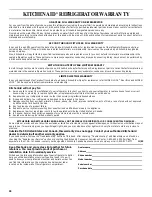
9
6. Adjust the front leveling bolt to bring the refrigerator top
parallel with the cabinet above the refrigerator. Leave
approximately
¹⁄₈
in. (3.18 mm) gap between the top hinges
and the cabinet. If you do not have a cabinet above the
refrigerator, simply adjust the refrigerator to make it level.
Style 1
1. Leave
¹⁄₈
in. (3.18 mm) minimum clearance for
leveling the refrigerator. Leave
¹⁄₄
in. (6.35 mm)
minimum clearance if you have full-overlay cabinet
doors.
2. Front of the refrigerator
Style 2
1. Leave
³⁄₄
in. (19.05 mm) minimum clearance
between a full-overlay cabinet door and a
refrigerator with a trim kit.
2. Front of the refrigerator
7. Adjust the rear leveling bolt to bring the refrigerator level with
the side cabinets or cabinet end panels.
8. If you want, you may now use the four leveling bolts to raise
the refrigerator to close the gap between the refrigerator top
hinge and the cabinet opening. Check that all four rollers still
touch the floor and that the cabinet doors above the
refrigerator open all the way.
NOTE: Cabinets with full-overlay doors will require
¹⁄₄
in. (6.35
mm) additional clearance between the top hinge and cabinet
to prevent the doors from hitting the hinge when opening. If
you have a trim panel kit on the refrigerator doors,
³⁄₄
in.
(19.05 mm) additional clearance is needed to prevent the
cabinet doors from hitting the refrigerator door trim.
9. Replace the base grille.
Understanding Sounds You May Hear
Your new refrigerator may make sounds that your old one didn’t
make. Because the sounds are new to you, you might be
concerned about them. Most of the new sounds are normal. Hard
surfaces, like the floor, walls, and cabinets, can make the sounds
seem louder than they actually are. The following describes the
kinds of sounds and what may be making them.
■
If your product is equipped with an ice maker, you will hear a
buzzing sound when the water valve opens to fill the ice
maker for each cycle.
■
The defrost timer will click when the automatic defrost cycle
begins and ends. Also, the Thermostat Control (or
Refrigerator Control depending on the model) will click when
cycling on and off.
■
Rattling noises may come from the flow of refrigerant, the
water line, or items stored on top of the refrigerator.
■
Your refrigerator is designed to run more efficiently to keep
your food items at the desired temperature. The high
efficiency compressor may cause your new refrigerator to run
longer than your old one, and you may hear a pulsating or
high-pitched sound.
■
Water dripping on the defrost heater during a defrost cycle
may cause a sizzling sound.
■
You may hear the evaporator fan motor circulating the air
through the refrigerator and freezer compartments.
■
As each cycle ends, you may hear a gurgling sound due to
the refrigerant flowing in your refrigerator.
■
Contraction and expansion of the inside walls may cause a
popping noise.
■
You may hear air being forced over the condenser by the
condenser fan.
■
You may hear water running into the drain pan during the
defrost cycle.
Summary of Contents for Cabinet Depth Side-by-Side Refrigerator
Page 25: ...25 WATERFILTERCERTIFICATIONS ...


